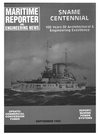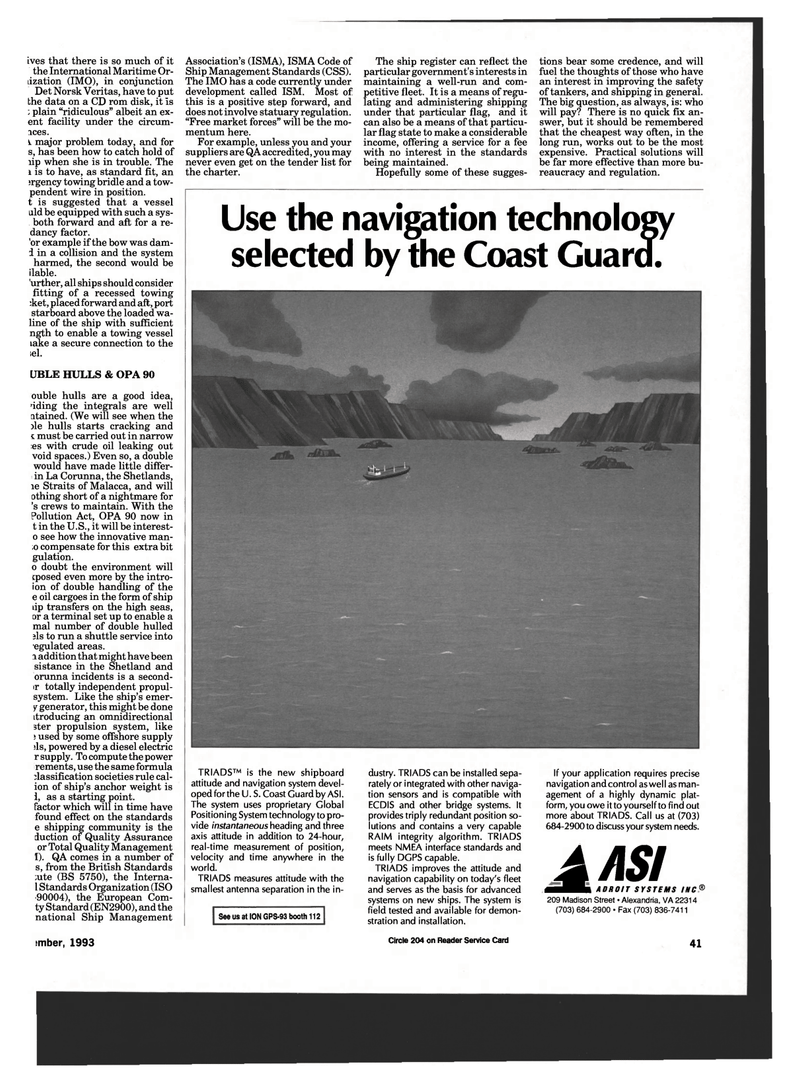
Page 39: of Maritime Reporter Magazine (September 1993)
Read this page in Pdf, Flash or Html5 edition of September 1993 Maritime Reporter Magazine
Lves that there is so much of it t the International Maritime Or- ization (IMO), in conjunction h Det Norsk Veritas, have to put the data on a CD rom disk, it is ; plain "ridiculous" albeit an ex- ent facility under the circum- ices. ^ major problem today, and for s, has been how to catch hold of lip when she is in trouble. The i is to have, as standard fit, an :rgency towing bridle and a tow- pendent wire in position, t is suggested that a vessel aid be equipped with such a sys- both forward and aft for a re- dancy factor. 'or example if the bow was dam- i in a collision and the system harmed, the second would be ilable. 'urther, all ships should consider fitting of a recessed towing ;ket, placed forward and aft, port starboard above the loaded wa- line of the ship with sufficient ngth to enable a towing vessel take a secure connection to the lei.
UBLE HULLS & OPA 90 ouble hulls are a good idea, 'iding the integrals are well atained. (We will see when the )le hulls starts cracking and i must be carried out in narrow :es with crude oil leaking out void spaces.) Even so, a double would have made little differ- in La Corunna, the Shetlands, le Straits of Malacca, and will othing short of a nightmare for 's crews to maintain. With the
Pollution Act, OPA 90 now in t in the U.S., it will be interest- o see how the innovative man- ;o compensate for this extra bit gulation. 0 doubt the environment will cposed even more by the intro- ion of double handling of the e oil cargoes in the form of ship
Lip transfers on the high seas, or a terminal set up to enable a mal number of double hulled 5ls to run a shuttle service into •egulated areas. 1 addition that might have been sistance in the Shetland and orunna incidents is a second- ir totally independent propul- system. Like the ship's emer- y generator, this might be done
Ltroducing an omnidirectional ster propulsion system, like : used by some offshore supply ;ls, powered by a diesel electric r supply. To compute the power rements, use the same formula classification societies rule cal- ion of ship's anchor weight is 1, as a starting point, factor which will in time have found effect on the standards e shipping community is the iuction of Quality Assurance or Total Quality Management
I). QA comes in a number of s, from the British Standards ;ute (BS 5750), the Interna- 1 Standards Organization (ISO •90004), the European Com- ty Standard (EN2900), and the national Ship Management
Association's (ISMA), ISMA Code of
Ship Management Standards (CSS).
The IMO has a code currently under development called ISM. Most of this is a positive step forward, and does not involve statuary regulation. "Free market forces" will be the mo- mentum here.
For example, unless you and your suppliers are QA accredited, you may never even get on the tender list for the charter.
The ship register can reflect the particular government's interests in maintaining a well-run and com- petitive fleet. It is a means of regu- lating and administering shipping under that particular flag, and it can also be a means of that particu- lar flag state to make a considerable income, offering a service for a fee with no interest in the standards being maintained.
Hopefully some of these sugges- tions bear some credence, and will fuel the thoughts of those who have an interest in improving the safety of tankers, and shipping in general.
The big question, as always, is: who will pay? There is no quick fix an- swer, but it should be remembered that the cheapest way often, in the long run, works out to be the most expensive. Practical solutions will be far more effective than more bu- reaucracy and regulation.
Use the navigation technology selected by the Coast Guard.
TRIADS™ is the new shipboard attitude and navigation system devel- oped for the U. S. Coast Guard by ASI.
The system uses proprietary Global
Positioning System technology to pro- vide instantaneous heading and three axis attitude in addition to 24-hour, real-time measurement of position, velocity and time anywhere in the world.
TRIADS measures attitude with the smallest antenna separation in the in-
See us at ION GPS-93 booth 112 dustry. TRIADS can be installed sepa- rately or integrated with other naviga- tion sensors and is compatible with
ECDIS and other bridge systems. It provides triply redundant position so- lutions and contains a very capable
RAIM integrity algorithm. TRIADS meets NMEA interface standards and is fully DGPS capable.
TRIADS improves the attitude and navigation capability on today's fleet and serves as the basis for advanced systems on new ships. The system is field tested and available for demon- stration and installation.
If your application requires precise navigation and control as well as man- agement of a highly dynamic plat- form, you owe it to yourself to find out more about TRIADS. Call us at (703) 684-2900 to discuss your system needs.
A AS/ mat/Km adroit systems ihc® 209 Madison Street • Alexandria, VA 22314 (703) 684-2900 • Fax (703) 836-7411 smber, 1993 Circle 204 on Reader Service Card 41

 38
38

 40
40
